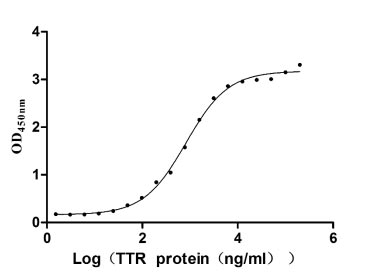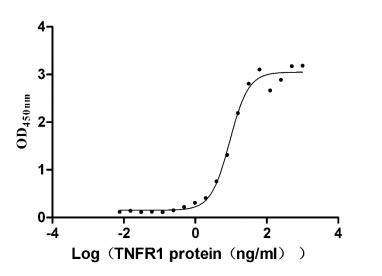Recombinant Mouse DnaJ homolog subfamily C member 5 (Dnajc5)
-
货号:CSB-YP007037MO
-
规格:
-
来源:Yeast
-
其他:
-
货号:CSB-EP007037MO
-
规格:
-
来源:E.coli
-
其他:
-
货号:CSB-EP007037MO-B
-
规格:
-
来源:E.coli
-
共轭:Avi-tag Biotinylated
E. coli biotin ligase (BirA) is highly specific in covalently attaching biotin to the 15 amino acid AviTag peptide. This recombinant protein was biotinylated in vivo by AviTag-BirA technology, which method is BriA catalyzes amide linkage between the biotin and the specific lysine of the AviTag.
-
其他:
-
货号:CSB-BP007037MO
-
规格:
-
来源:Baculovirus
-
其他:
-
货号:CSB-MP007037MO
-
规格:
-
来源:Mammalian cell
-
其他:
产品详情
-
纯度:>85% (SDS-PAGE)
-
基因名:
-
Uniprot No.:
-
别名:Dnajc5DnaJ homolog subfamily C member 5; Cysteine string protein; CSP
-
种属:Mus musculus (Mouse)
-
蛋白长度:Full length protein
-
表达区域:1-198
-
氨基酸序列MADQRQRSLS TSGESLYHVL GLDKNATSDD IKKSYRKLAL KYHPDKNPDN PEAADKFKEI NNAHAILTDA TKRNIYDKYG SLGLYVAEQF GEENVNTYFV LSSWWAKALF VVCGLLTCCY CCCCLCCCFN CCCGKCKPKA PEGEETEFYV SPEDLEAQLQ SDEREATDTP IVIQPASATE TTQLTADSHP SYHTDGFN
-
蛋白标签:Tag type will be determined during the manufacturing process.
The tag type will be determined during production process. If you have specified tag type, please tell us and we will develop the specified tag preferentially. -
产品提供形式:Lyophilized powder
Note: We will preferentially ship the format that we have in stock, however, if you have any special requirement for the format, please remark your requirement when placing the order, we will prepare according to your demand. -
复溶:We recommend that this vial be briefly centrifuged prior to opening to bring the contents to the bottom. Please reconstitute protein in deionized sterile water to a concentration of 0.1-1.0 mg/mL.We recommend to add 5-50% of glycerol (final concentration) and aliquot for long-term storage at -20℃/-80℃. Our default final concentration of glycerol is 50%. Customers could use it as reference.
-
储存条件:Store at -20°C/-80°C upon receipt, aliquoting is necessary for mutiple use. Avoid repeated freeze-thaw cycles.
-
保质期:The shelf life is related to many factors, storage state, buffer ingredients, storage temperature and the stability of the protein itself.
Generally, the shelf life of liquid form is 6 months at -20°C/-80°C. The shelf life of lyophilized form is 12 months at -20°C/-80°C. -
货期:Delivery time may differ from different purchasing way or location, please kindly consult your local distributors for specific delivery time.Note: All of our proteins are default shipped with normal blue ice packs, if you request to ship with dry ice, please communicate with us in advance and extra fees will be charged.
-
注意事项:Repeated freezing and thawing is not recommended. Store working aliquots at 4°C for up to one week.
-
Datasheet :Please contact us to get it.
靶点详情
-
功能:Acts as a co-chaperone for the SNARE protein SNAP-25. Involved in the calcium-mediated control of a late stage of exocytosis. Acts as a general chaperone in regulated exocytosis. May have an important role in presynaptic function. May be involved in calcium-dependent neurotransmitter release at nerve endings.
-
基因功能参考文献:
- Results indicate that by assisting local lysosome/proteasome processes, CSPalpha-mediated removal of toxic proteins via extracellular vesicles plays a central role in synaptic proteostasis. PMID: 28424476
- These data show that neurodegenerative processes associated with lysosomal dysfunction may be presynaptically initiated by a concomitant reduction in alpha-synuclein and CSPalpha levels at nerve terminals. PMID: 27881461
- CSPalpha has a role in regulating synaptic excitability and neurotransmission by limiting expression of BK channels. PMID: 24475152
- The mRNA and protein expression of CSP1 was elevated in 3T3-L1 adipocytes in insulin resistant states caused by high levels of palmitate and chronic insulin exposure. PMID: 24190036
- gamma-Synuclein binds synaptic vesicles but is unable to rescue the phenotype of CSPalpha-deficient mice. PMID: 23129765
- Using hippocampal cultures, study shows that CSPalpha regulates the stability of client proteins and synaptic vesicle number. Analysis of CSPalpha-dynamin 1 interactions reveals unexpectedly that CSPalpha regulates the polymerization of dynamin 1. PMID: 22500636
- Study shows that cysteine string protein-alpha is required to maintain the size of the releasable pool of synaptic vesicles in motorneurons, presumably by conveying stability to SNAP-25. PMID: 22500637
- findings suggest that the neurodegeneration in CSPalpha KO mice is primarily produced by defective SNAP-25 function, which causes neurodegeneration by impairing SNARE-complex assembly PMID: 22187053
- Data indicate that Cspalpha interacts with Syt9, and such a complex may be relevant in the calcium-mediated control of a late stage of exocytosis by triggering the specific recruitment of a folding catalyst at the fusion point. PMID: 20847230
- Data show that deletion of CSPalpha produces an abnormal SNAP-25 conformer that inhibits SNARE-complex formation, and is subject to ubiquitylation and proteasomal degradation. PMID: 21151134
- CSPalpha is not essential for the normal operation of Ca2+ channels or exocytosis but acts as a presynaptic chaperone that maintains continued synaptic function. Its deletion causes postnatal lethality of knockout mice. PMID: 15091340
- Tonically active ribbon synapses in retina are particularly sensitive to the deletion of CSPalpha and that expression of at least one CSP isoform is essential to protect such tonically active synapses from neurodegeneration. PMID: 16477021
- palmitoylation of CSP is enhanced specifically by co-expression of the Golgi-localized palmitoyl transferases DHHC3, DHHC7, DHHC15, or DHHC17 PMID: 18596047
- CSPalpha is indispensable for a normal Ca2+ sensitivity of exocytosis in vertebrate mature synapses PMID: 18598257
- a role for Hsp40 crosstalk with CSPalpha in neuroprotection. PMID: 19242542
显示更多
收起更多
-
亚细胞定位:Cytoplasm, cytosol. Membrane; Lipid-anchor. Cytoplasmic vesicle, secretory vesicle, chromaffin granule membrane. Melanosome. Cell membrane.
-
数据库链接:
KEGG: mmu:13002
STRING: 10090.ENSMUSP00000072175
UniGene: Mm.140761
Most popular with customers
-
Recombinant Human Retinol-binding protein 4 (RBP4) (Active)
Express system: Mammalian cell
Species: Homo sapiens (Human)
-
Recombinant Human Tumor necrosis factor receptor superfamily member 1A (TNFRSF1A), partial (Active)
Express system: Mammalian cell
Species: Homo sapiens (Human)
-
Recombinant Human Myosin regulatory light chain 12B(MYL12B) (Active)
Express system: E.coli
Species: Homo sapiens (Human)
-
Recombinant Human C-C chemokine receptor type 6(CCR6)-VLPs (Active)
Express system: Mammalian cell
Species: Homo sapiens (Human)
-
Recombinant Human C-C chemokine receptor type 9 (CCR9)-VLPs (Active)
Express system: Mammalian cell
Species: Homo sapiens (Human)
-
Recombinant DT3C (Diphtheria toxin & spg 3C domain) for Antibody Internalization Assay (Active)
Express system: E.coli
Species: N/A


















